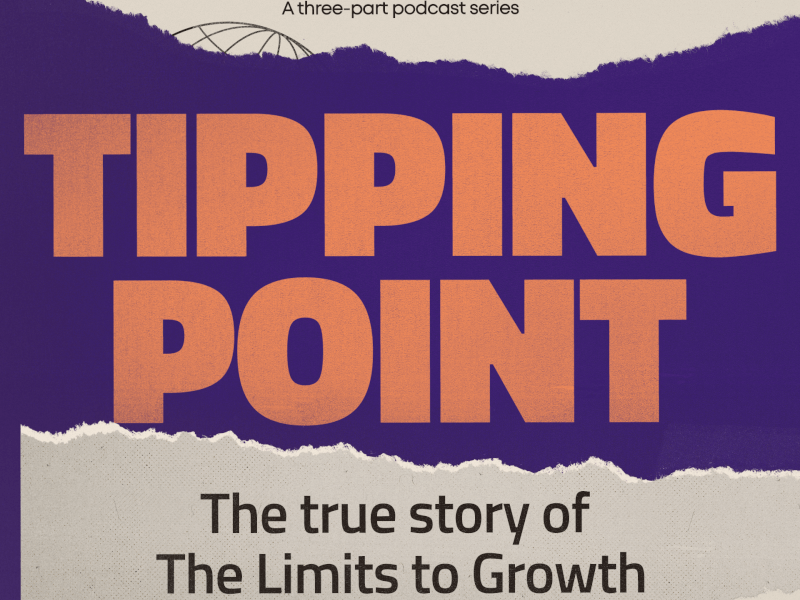25 July 2023 – Several years ago Vegard Beyer and I met at a summer school organised by The Club of Rome. That is where we first learned about the landmark study it had commissioned: 1972’s The Limits to Growth. The report warned that unfettered economic growth could lead to a collapse in our global society by the middle of the 21st century. The causes: an exponential rise in pollution coupled with an unsustainable loss of nature.
We were keen to understand why its prophetic conclusions had been ignored–so we set out to investigate. Our three-part, true-crime style podcast, Tipping Point, released in May 2023, is the result of around four years of archive and interview research. The story is told from the perspective of the book’s author and sustainability pioneer Donella (Dana) Meadows, inspired by a written account she made before her untimely death in 2001.
Here are some of our most interesting findings:
Their work was initially well-received by leading political figures who understood the concept of risk
The Limits to Growth has been the subject of much controversy over the years–much, as we would discover–was undue. We were particularly surprised to learn how positively it was received by politicians, most notably Elliot Richardson, Secretary of State for Health and Education under President Nixon, who called the study “too thoughtful, too thorough, and the implications too disastrous if we are to be wrong in underestimating them.” He argued that countries such as the United States had provisions in place for disasters with far smaller probabilities, and even commissioned his own investigation into limits to growth. But by the time it was completed, the backlash had greatly damaged the book’s reputation, while Richardson himself had resigned in protest at the Watergate scandal.
Most critics did not understand or engage with the science
The scenarios described in The Limits to Growth were based on a new and pioneering scientific method called systems dynamics, the brainchild of computer genius Jay Forrester. The MIT team which developed Forrester’s world model had originally been working on a detailed paper for scientific review. But our podcast details the wild circumstances that led a meeting of a few dozen scientists to morph into a glitzy affair for hundreds of dignitaries and the world’s press, and led team member Dana Meadows’ non-technical summary to The Club of Rome to become an environmental best-seller before their scientific report was complete. This left plenty of fodder for critics who reject the book’s conclusions–despite having never reviewed the model. “Nonsense” is how renowned Yale economist Henry Wallich dismissed it, a critique later echoed in The Economist, Newsweek, The New York Times and elsewhere.
In the 1970s even mainstream scientists believed pollution would go down, not up
While economists have been The Limits to Growth’s most enduring critics, we were surprised to learn how even renowned scientists initially rejected its premises. At the book launch, Science editor Philip Abelson described pollution simply as a “problem of poor housekeeping” and claimed that it was set to fall now that companies were “busy about the job”. This viewpoint can partly be explained by growing public concern about the environment: 1970 saw the first Earth Day and the establishment of the Environmental Protection Agency, after all. But the MIT team observed that rapid industrial expansion was causing pollution and resource depletion to grow exponentially–partly as new industries tend to create new forms of environmental damage which build up over time, and partly as those profiting from pollution seek to escape regulation. Thus, contrary to prevailing opinion, the team concluded that if growth were to continue in this way, the related problems could soon overcome our ability to manage them.
We need a new vision of prosperity beyond growth
The Limits to Growth arrived as governments were starting to tackle pollution and had just sent men to the moon. It is perhaps not surprising its proposals were initially dismissed, even, as we detail in our podcast, by some members of The Club of Rome. And yet today there is growing scientific consensus that we have now vastly overstepped earth’s sustainable limits–not least as regards our climate system. Despite this, most leaders continue to seek more growth as the answer to our problems. After years of research and contemplation, in her 1992 update Beyond the Limits, Dana Meadows argued the problem is not a lack of evidence, but rather, the lack of an alternative vision. She put forward that to create a sustainable world we must replace the growth paradigm with a new vision of prosperity. Though the hour is late, with developments such as Wellbeing Economics, Doughnut Economics and the Club of Rome’s Earth4All initiative, we are encouraged that this effort is now underway.






